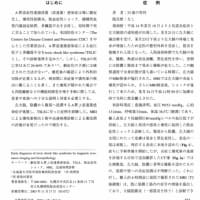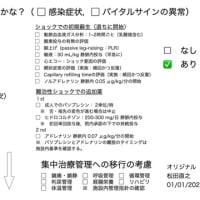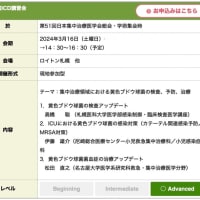British Journal of Pharmacology 2012年5月号では,cAMPが特集されています。
EPAC(exchange protein activated by cAMP)も最近は極めて有名な細胞内情報伝達蛋白となりました。
名大救急・集中治療ジャーナルクラブ ~毎週木曜日開催中~
総説
■ Charlotte K Billington and Ian P Hall. Novel cAMP signalling paradigms: therapeutic implications for airway disease (pages 401–410)
■ Jessica Tröger, et al. A-kinase anchoring proteins as potential drug targets (pages 420–433)
■ Paul A Insel, et al. cAMP and Epac in the regulation of tissue fibrosis (pages 447–456)
Fibrosis, the result of excess deposition of extracellular matrix (ECM), in particular collagen, leads to scarring and loss of function in tissues that include the heart, lung, kidney and liver. The second messenger cAMP can inhibit the formation and extent of ECM during this late phase of inflammation, but the mechanisms for these actions of cAMP and of agents that elevate tissue cAMP levels are not well understood. In this article, we review the fibrotic process and focus on two recently recognized aspects of actions of cAMP and its effector Epac (Exchange protein activated by cAMP): (a) blunting of epithelial–mesenchymal transformation (EMT) and (b) down-regulation of Epac expression by profibrotic agents (e.g. TGF-β, angiotensin II), which may promote tissue fibrosis by decreasing Epac-mediated antifibrotic actions. Pharmacological approaches that raise cAMP or blunt the decrease in Epac expression by profibrotic agents may thus be strategies to block or perhaps reverse tissue fibrosis.
■ Kristoffer Watten Brudvik and Kjetil Taskén. Modulation of T cell immune functions by the prostaglandin E2 – cAMP pathway in chronic inflammatory states (pages 411–419)
Cyclic AMP is the intracellular second messenger for a variety of immunoregulatory inflammatory mediators such as prostaglandin E2, adenosine and histamine that signal to effector T cells from monocytes, macrophages and regulatory T cells. Protein kinase A (PKA) type I localizes to lipid rafts in effector T cells during T cell activation and directly modulates proximal signal events including phosphorylation of C-terminal Src kinase (Csk), which initiates a negative signal pathway that fine-tunes the T cell activation process. The PKA-Csk immunoregulatory pathway is scaffolded by the A kinase anchoring protein ezrin, the Csk binding protein phosphoprotein associated with glycosphingolipid-enriched membrane microdomains and the linker protein ezrin/radixin/moesin binding protein of 50 kDa. This pathway is hyperactivated in chronic infections with an inflammatory component such as HIV, other immunodeficiencies and around solid tumours as a consequence of local inflammation leading to inhibition of anti-tumour immunity.
■ Euan Parnell, et al. Regulation of the inflammatory response of vascular endothelial cells by EPAC1 (pages 434–446)
Life-threatening diseases of the cardiovascular system, like atherosclerosis, are exacerbated by unwanted inflammation within the structures of large blood vessels. This inflammation involves increased permeability of the vascular endothelial cells (VECs) that form the lining of blood vessels, leading to exaggerated extravasation of blood components and accumulation of fluid in the extravascular space. This results in tissue dysfunction and increased secretion of chemokines that attract leukocytes and monocytes to the inflamed endothelium. Cyclic AMP is synthesized in VECs in response to endogenous Gs-coupled receptors and is known to limit cytokine action and reduce endothelial hyperpermeability induced by multiple pro-inflammatory stimuli. The mechanisms underlying this anti-inflammatory action of cyclic AMP are now being elucidated and it is becoming clear that the cyclic AMP sensor, exchange protein activated by cyclic AMP (EPAC1), appears to play a key role in suppressing unwanted inflammation. EPAC1 mediates at least three anti-inflammatory pathways in VECs by down-regulating inflammatory signalling through the induction of the suppressors of cytokine signalling 3 (SOCS-3) gene, limiting integrin-dependent vascular permeability and enhancing endothelial barrier function through the stabilization of VE-cadherin junctions. Given that manipulation of cellular cyclic AMP levels currently forms the basis of many effective pharmaceuticals and that EPAC1 is involved in multiple anti-inflammatory protective processes in VECs, does this make EPAC1 an attractive target for the development of activators capable of eliciting a coordinated programme of ‘protection’ against the development of endothelial dysfunction? Here we discuss whether EPAC1 represents an attractive therapeutic target for limiting endothelial dysfunction associated with cardiovascular diseases like atherosclerosis.


Original Article
■ β-Adrenergic receptors stimulate interleukin-6 production through Epac-dependent activation of PKCδ/p38 MAPK signalling in neonatal mouse cardiac fibroblasts (pages 676–688)
心筋線維芽細胞にはアドレナリン作動性β-受容体が存在し,ドパミンやドブタミンによるβ-受容体刺激はEPAC-1を介してPKCδを活性化させ,線維芽細胞の増殖刺激となるばかりか,IL-6などのサイトカインを産生する。
BACKGROUND AND PURPOSE IL-6 plays crucial roles in cardiac hypertrophy, cardiac fibrosis and heart failure. Activation of β-adrenoceptors induced IL-6 production in neonatal mouse cardiac fibroblasts (NMCFs) through a Gs/adenylate cyclase/cAMP/p38 MAPK pathway but independent of PKA. However, how cAMP activates p38 MAPK is still not defined. In this study, we have assessed the role of the exchange protein directly activated by cAMP (Epac) and PKCδ in p38 MAPK activation and IL-6 production by stimulated by the β-adrenoceptor agonist isoprenaline in NMCFs.
EXPERIMENTAL APPROACH The IL-6 concentration in cell culture supernatants was measured by ELISA. The levels of phosphorylated and total p38 MAPK and PKCδ were determined by Western blot analysis. The translocation of PKCδ was determined by immunoblotting the soluble and particulate fractions. Expression of Epac1 or PKCδ was knocked down by the corresponding, adenovirus-mediated, small hairpin RNA (shRNA).
RESULTS In NMCFs, activation of β-adrenoceptors enhanced PKCδ phosphorylation and translocation. Furthermore, knock-down of the PKCδ isoform using an adenovirus-mediated shRNA markedly down-regulated IL-6 induction by NMCFs stimulated with isoprenaline. Moreover, knock-down of Epac1 confirmed that Epac1 was upstream of PKCδ in IL-6 production. Additionally, both Epac1 and PKCδ mediated the p38 MAPK activation induced by isoprenaline.
CONCLUSIONS AND IMPLICATIONS β-Adrenoceptor agonists activate a cAMP/Epac/PKCδ/p38 MAPK pathway to produce IL-6 in NMCFs. This study identifies Epac as the link between cAMP and p38 MAPK signalling pathways and demonstrates that PKCδ can function as a novel downstream effector of this β-adrenoceptor/cAMP/Epac pathway.
■ Michaela Kuhn. Endothelial actions of atrial and B-type natriuretic peptides (pages 522–531)
The cardiac hormone atrial natriuretic peptide (ANP) is critically involved in the maintenance of arterial blood pressure and intravascular volume homeostasis. Its cGMP-producing GC-A receptor is densely expressed in the microvascular endothelium of the lung and systemic circulation, but the functional relevance is controversial. Some studies reported that ANP stimulates endothelial cell permeability, whereas others described that the peptide attenuates endothelial barrier dysfunction provoked by inflammatory agents such as thrombin or histamine. Many studies in vitro addressed the effects of ANP on endothelial proliferation and migration. Again, both pro- and anti-angiogenic properties were described. To unravel the role of the endothelial actions of ANP in vivo, we inactivated the murine GC-A gene selectively in endothelial cells by homologous loxP/Cre-mediated recombination. Our studies in these mice indicate that ANP, via endothelial GC-A, increases endothelial albumin permeability in the microcirculation of the skin and skeletal muscle. This effect is critically involved in the endocrine hypovolaemic, hypotensive actions of the cardiac hormone. On the other hand the homologous GC-A-activating B-type NP (BNP), which is produced by cardiac myocytes and many other cell types in response to stressors such as hypoxia, possibly exerts more paracrine than endocrine actions. For instance, within the ischaemic skeletal muscle BNP released from activated satellite cells can improve the regeneration of neighbouring endothelia. This review will focus on recent advancements in our understanding of endothelial NP/GC-A signalling in the pulmonary versus systemic circulation. It will discuss possible mechanisms accounting for the discrepant observations made for the endothelial actions of this hormone-receptor system and distinguish between (patho)physiological and pharmacological actions. Lastly it will emphasize the potential therapeutical implications derived from the actions of NPs on endothelial permeability and regeneration.
■ EH Kaufman and DB Jacoby. Upping the antedrug: is a novel anti-inflammatory Toll-like receptor 7 agonist also a bronchodilator? (pages 569–572)
In this issue of British Journal of Pharmacology, Biffen and colleagues present a novel Toll-like receptor 7 (TLR7) antedrug to treat allergic disease that is rapidly metabolized in the lung to limit side effects due to systemic exposure. Asthma is characterized as an allergic disease of the lung, and TLR7 agonists are proposed to ameliorate allergic inflammation in the lung, a characteristic of prophylactic medications. We have previously shown that TLR7 agonists of multiple structural classes are acute bronchodilators, characteristic of rescue medication for asthma attacks. It will be interesting to determine whether the bronchodilating effect extends to the novel class of TLR7 agonists described here for a prophylactic and rescue therapy in one drug. Combined with the antedrug approach, this would further limit side effects improving on current combination therapies.
■ M Biffen, et al. Biological characterization of a novel class of toll-like receptor 7 agonists designed to have reduced systemic activity (pages 573–586)
BACKGROUND AND PURPOSE Toll-like receptor 7 (TLR7) agonists have potential in the treatment of allergic diseases. However, the therapeutic utility of current low molecular weight TLR7 agonists is limited by their systemic activity, resulting in unwanted side effects. We have developed a series of TLR7-selective ‘antedrugs’, including SM-324405 and AZ12441970, which contain an ester group rapidly cleaved in plasma to reduce systemic exposure.
EXPERIMENTAL APPROACH Agonist activity at TLR7 of the parent ester and acid metabolite was assessed in vitro in reporter cells and primary cells from a number of species. Pharmacokinetics following a dose to the lungs was assessed in mice and efficacy evaluated in vivo with a mouse allergic airway model.
KEY RESULTS Compounds were selective agonists for TLR7 with no crossover to TLR8 and were metabolically unstable in plasma with the acid metabolite showing substantially reduced activity in a number of assays. The compounds inhibited IL-5 production and induced IFN-α, which mediated the inhibition of IL-5. When dosed into the lung the compounds were rapidly metabolized and short-term exposure of the ‘antedrug’ was sufficient to activate the IFN pathway. AZ12441970 showed efficacy in a mouse allergic airway model with minimal induction of systemic IFN-α, consistent with the low plasma levels of compound.
CONCLUSIONS AND IMPLICATIONS The biological and metabolic profiles of these TLR7-selective agonist ‘antedrug’ compounds are consistent with a new class of compound that could be administered locally for the treatment of allergic diseases, while reducing the risk of systemic side effects.
■ Yimin Yuan, et al. Ethyl pyruvate promotes spinal cord repair by ameliorating the glial microenvironment (pages 749–763)
BACKGROUND AND PURPOSE Spinal cord injury (SCI) triggers a series of endogenous processes, including neuroinflammation and reactive astrogliosis, which may contribute to the failure of neural regeneration and functional recovery. In the present study, the effect of ethyl pyruvate on spinal cord repair was explored.
EXPERIMENTAL APPROACH Functional assessment and histological analyses of astrogliosis, neuroinflammation, neuronal survival and axonal regeneration were performed to investigate the effects of ethyl pyruvate (0.086, 0.215, 0.431 or 0.646 mmol·kg-1·day-1) on spinal cord repair in a rat model of SCI. The effect of ethyl pyruvate (5, 10 or 15 mM) on astrocytic activation was also evaluated in an in vitro‘scratch-wound’ model.
KEY RESULTS Functional assessment showed evident improvement of behavioural functions in the ethyl pyruvate-treated rats. Reactive astrogliosis was significantly inhibited in vivo, after injection of ethyl pyruvate (0.431 mmol·kg-1day-1), and in vitro‘scratch-wound’ model in the presence of 10 or 15 mM ethyl pyruvate. The difference between effective concentration in vitro and in vivo suggests that the inhibitory effect of ethyl pyruvate on astrogliosis in damaged spinal cord is indirect. In addition, ethyl pyruvate (0.431 mmol·kg-1day-1) attenuated SCI-induced neuroinflammation; it decreased the Iba-1-, ED-1- and CD11b-positive cells at the lesion site. Importantly, histological analyses showed a significantly greater number of surviving neurons and regenerative axons in the ethyl pyruvate-treated rats.
CONCLUSIONS AND IMPLICATIONS Ethyl pyruvate was shown to inhibit astrogliosis and neuroinflammation, promote neuron survival and neural regeneration, and improve the functional recovery of spinal cord, indicating a potential neuroprotective effect of ethyl pyruvate against SCI.
■ K Kawamoto, et al. Inhibitory effects of dopamine on spinal synaptic transmission via dopamine D1-like receptors in neonatal rats (pages 788–800)
BACKGROUND AND PURPOSE Dopamine released from the endings of descending dopaminergic nerve fibres in the spinal cord may be involved in modulating functions such as locomotion and nociception. Here, we examined the effects of dopamine on spinal synaptic transmissions in rats.
EXPERIMENTAL APPROACH Spinal reflex potentials, monosynaptic reflex potential (MSR) and slow ventral root potential (sVRP), were measured in the isolated spinal cord of the neonatal rat. Dopamine release was measured by HPLC.
KEY RESULTS Dopamine at lower concentrations (<1 µM) depressed sVRP, which is a C fibre-evoked polysynaptic response and believed to reflect nociceptive transmission. At higher concentrations (>1 µM), in addition to a potent sVRP depression, dopamine depolarized baseline potential and slightly depressed MSR. Depression of sVRP by dopamine was partially reversed by dopamine D1-like but not by D2-like receptor antagonists. SKF83959 and SKF81297, D1-like receptor agonists, and methamphetamine, an endogenous dopamine releaser, also caused the inhibition of sVRP. Methamphetamine also depressed MSR, which was inhibited by ketanserin, a 5-HT2A/2C receptor antagonist. Methamphetamine induced the release of dopamine and 5-HT from spinal cords, indicating that the release of endogenous dopamine and 5-HT depresses sVRP and MSR respectively.
CONCLUSION AND IMPLICATIONS These results suggested that dopamine at lower concentrations preferentially inhibited sVRP, which is mediated via dopamine D1-like and other unidentified receptors. The dopamine-evoked depression is involved in modulating the spinal functions by the descending dopaminergic pathways.
EPAC(exchange protein activated by cAMP)も最近は極めて有名な細胞内情報伝達蛋白となりました。
名大救急・集中治療ジャーナルクラブ ~毎週木曜日開催中~
総説
■ Charlotte K Billington and Ian P Hall. Novel cAMP signalling paradigms: therapeutic implications for airway disease (pages 401–410)
■ Jessica Tröger, et al. A-kinase anchoring proteins as potential drug targets (pages 420–433)
■ Paul A Insel, et al. cAMP and Epac in the regulation of tissue fibrosis (pages 447–456)
Fibrosis, the result of excess deposition of extracellular matrix (ECM), in particular collagen, leads to scarring and loss of function in tissues that include the heart, lung, kidney and liver. The second messenger cAMP can inhibit the formation and extent of ECM during this late phase of inflammation, but the mechanisms for these actions of cAMP and of agents that elevate tissue cAMP levels are not well understood. In this article, we review the fibrotic process and focus on two recently recognized aspects of actions of cAMP and its effector Epac (Exchange protein activated by cAMP): (a) blunting of epithelial–mesenchymal transformation (EMT) and (b) down-regulation of Epac expression by profibrotic agents (e.g. TGF-β, angiotensin II), which may promote tissue fibrosis by decreasing Epac-mediated antifibrotic actions. Pharmacological approaches that raise cAMP or blunt the decrease in Epac expression by profibrotic agents may thus be strategies to block or perhaps reverse tissue fibrosis.
■ Kristoffer Watten Brudvik and Kjetil Taskén. Modulation of T cell immune functions by the prostaglandin E2 – cAMP pathway in chronic inflammatory states (pages 411–419)
Cyclic AMP is the intracellular second messenger for a variety of immunoregulatory inflammatory mediators such as prostaglandin E2, adenosine and histamine that signal to effector T cells from monocytes, macrophages and regulatory T cells. Protein kinase A (PKA) type I localizes to lipid rafts in effector T cells during T cell activation and directly modulates proximal signal events including phosphorylation of C-terminal Src kinase (Csk), which initiates a negative signal pathway that fine-tunes the T cell activation process. The PKA-Csk immunoregulatory pathway is scaffolded by the A kinase anchoring protein ezrin, the Csk binding protein phosphoprotein associated with glycosphingolipid-enriched membrane microdomains and the linker protein ezrin/radixin/moesin binding protein of 50 kDa. This pathway is hyperactivated in chronic infections with an inflammatory component such as HIV, other immunodeficiencies and around solid tumours as a consequence of local inflammation leading to inhibition of anti-tumour immunity.
■ Euan Parnell, et al. Regulation of the inflammatory response of vascular endothelial cells by EPAC1 (pages 434–446)
Life-threatening diseases of the cardiovascular system, like atherosclerosis, are exacerbated by unwanted inflammation within the structures of large blood vessels. This inflammation involves increased permeability of the vascular endothelial cells (VECs) that form the lining of blood vessels, leading to exaggerated extravasation of blood components and accumulation of fluid in the extravascular space. This results in tissue dysfunction and increased secretion of chemokines that attract leukocytes and monocytes to the inflamed endothelium. Cyclic AMP is synthesized in VECs in response to endogenous Gs-coupled receptors and is known to limit cytokine action and reduce endothelial hyperpermeability induced by multiple pro-inflammatory stimuli. The mechanisms underlying this anti-inflammatory action of cyclic AMP are now being elucidated and it is becoming clear that the cyclic AMP sensor, exchange protein activated by cyclic AMP (EPAC1), appears to play a key role in suppressing unwanted inflammation. EPAC1 mediates at least three anti-inflammatory pathways in VECs by down-regulating inflammatory signalling through the induction of the suppressors of cytokine signalling 3 (SOCS-3) gene, limiting integrin-dependent vascular permeability and enhancing endothelial barrier function through the stabilization of VE-cadherin junctions. Given that manipulation of cellular cyclic AMP levels currently forms the basis of many effective pharmaceuticals and that EPAC1 is involved in multiple anti-inflammatory protective processes in VECs, does this make EPAC1 an attractive target for the development of activators capable of eliciting a coordinated programme of ‘protection’ against the development of endothelial dysfunction? Here we discuss whether EPAC1 represents an attractive therapeutic target for limiting endothelial dysfunction associated with cardiovascular diseases like atherosclerosis.


Original Article
■ β-Adrenergic receptors stimulate interleukin-6 production through Epac-dependent activation of PKCδ/p38 MAPK signalling in neonatal mouse cardiac fibroblasts (pages 676–688)
心筋線維芽細胞にはアドレナリン作動性β-受容体が存在し,ドパミンやドブタミンによるβ-受容体刺激はEPAC-1を介してPKCδを活性化させ,線維芽細胞の増殖刺激となるばかりか,IL-6などのサイトカインを産生する。
BACKGROUND AND PURPOSE IL-6 plays crucial roles in cardiac hypertrophy, cardiac fibrosis and heart failure. Activation of β-adrenoceptors induced IL-6 production in neonatal mouse cardiac fibroblasts (NMCFs) through a Gs/adenylate cyclase/cAMP/p38 MAPK pathway but independent of PKA. However, how cAMP activates p38 MAPK is still not defined. In this study, we have assessed the role of the exchange protein directly activated by cAMP (Epac) and PKCδ in p38 MAPK activation and IL-6 production by stimulated by the β-adrenoceptor agonist isoprenaline in NMCFs.
EXPERIMENTAL APPROACH The IL-6 concentration in cell culture supernatants was measured by ELISA. The levels of phosphorylated and total p38 MAPK and PKCδ were determined by Western blot analysis. The translocation of PKCδ was determined by immunoblotting the soluble and particulate fractions. Expression of Epac1 or PKCδ was knocked down by the corresponding, adenovirus-mediated, small hairpin RNA (shRNA).
RESULTS In NMCFs, activation of β-adrenoceptors enhanced PKCδ phosphorylation and translocation. Furthermore, knock-down of the PKCδ isoform using an adenovirus-mediated shRNA markedly down-regulated IL-6 induction by NMCFs stimulated with isoprenaline. Moreover, knock-down of Epac1 confirmed that Epac1 was upstream of PKCδ in IL-6 production. Additionally, both Epac1 and PKCδ mediated the p38 MAPK activation induced by isoprenaline.
CONCLUSIONS AND IMPLICATIONS β-Adrenoceptor agonists activate a cAMP/Epac/PKCδ/p38 MAPK pathway to produce IL-6 in NMCFs. This study identifies Epac as the link between cAMP and p38 MAPK signalling pathways and demonstrates that PKCδ can function as a novel downstream effector of this β-adrenoceptor/cAMP/Epac pathway.
■ Michaela Kuhn. Endothelial actions of atrial and B-type natriuretic peptides (pages 522–531)
The cardiac hormone atrial natriuretic peptide (ANP) is critically involved in the maintenance of arterial blood pressure and intravascular volume homeostasis. Its cGMP-producing GC-A receptor is densely expressed in the microvascular endothelium of the lung and systemic circulation, but the functional relevance is controversial. Some studies reported that ANP stimulates endothelial cell permeability, whereas others described that the peptide attenuates endothelial barrier dysfunction provoked by inflammatory agents such as thrombin or histamine. Many studies in vitro addressed the effects of ANP on endothelial proliferation and migration. Again, both pro- and anti-angiogenic properties were described. To unravel the role of the endothelial actions of ANP in vivo, we inactivated the murine GC-A gene selectively in endothelial cells by homologous loxP/Cre-mediated recombination. Our studies in these mice indicate that ANP, via endothelial GC-A, increases endothelial albumin permeability in the microcirculation of the skin and skeletal muscle. This effect is critically involved in the endocrine hypovolaemic, hypotensive actions of the cardiac hormone. On the other hand the homologous GC-A-activating B-type NP (BNP), which is produced by cardiac myocytes and many other cell types in response to stressors such as hypoxia, possibly exerts more paracrine than endocrine actions. For instance, within the ischaemic skeletal muscle BNP released from activated satellite cells can improve the regeneration of neighbouring endothelia. This review will focus on recent advancements in our understanding of endothelial NP/GC-A signalling in the pulmonary versus systemic circulation. It will discuss possible mechanisms accounting for the discrepant observations made for the endothelial actions of this hormone-receptor system and distinguish between (patho)physiological and pharmacological actions. Lastly it will emphasize the potential therapeutical implications derived from the actions of NPs on endothelial permeability and regeneration.
■ EH Kaufman and DB Jacoby. Upping the antedrug: is a novel anti-inflammatory Toll-like receptor 7 agonist also a bronchodilator? (pages 569–572)
In this issue of British Journal of Pharmacology, Biffen and colleagues present a novel Toll-like receptor 7 (TLR7) antedrug to treat allergic disease that is rapidly metabolized in the lung to limit side effects due to systemic exposure. Asthma is characterized as an allergic disease of the lung, and TLR7 agonists are proposed to ameliorate allergic inflammation in the lung, a characteristic of prophylactic medications. We have previously shown that TLR7 agonists of multiple structural classes are acute bronchodilators, characteristic of rescue medication for asthma attacks. It will be interesting to determine whether the bronchodilating effect extends to the novel class of TLR7 agonists described here for a prophylactic and rescue therapy in one drug. Combined with the antedrug approach, this would further limit side effects improving on current combination therapies.
■ M Biffen, et al. Biological characterization of a novel class of toll-like receptor 7 agonists designed to have reduced systemic activity (pages 573–586)
BACKGROUND AND PURPOSE Toll-like receptor 7 (TLR7) agonists have potential in the treatment of allergic diseases. However, the therapeutic utility of current low molecular weight TLR7 agonists is limited by their systemic activity, resulting in unwanted side effects. We have developed a series of TLR7-selective ‘antedrugs’, including SM-324405 and AZ12441970, which contain an ester group rapidly cleaved in plasma to reduce systemic exposure.
EXPERIMENTAL APPROACH Agonist activity at TLR7 of the parent ester and acid metabolite was assessed in vitro in reporter cells and primary cells from a number of species. Pharmacokinetics following a dose to the lungs was assessed in mice and efficacy evaluated in vivo with a mouse allergic airway model.
KEY RESULTS Compounds were selective agonists for TLR7 with no crossover to TLR8 and were metabolically unstable in plasma with the acid metabolite showing substantially reduced activity in a number of assays. The compounds inhibited IL-5 production and induced IFN-α, which mediated the inhibition of IL-5. When dosed into the lung the compounds were rapidly metabolized and short-term exposure of the ‘antedrug’ was sufficient to activate the IFN pathway. AZ12441970 showed efficacy in a mouse allergic airway model with minimal induction of systemic IFN-α, consistent with the low plasma levels of compound.
CONCLUSIONS AND IMPLICATIONS The biological and metabolic profiles of these TLR7-selective agonist ‘antedrug’ compounds are consistent with a new class of compound that could be administered locally for the treatment of allergic diseases, while reducing the risk of systemic side effects.
■ Yimin Yuan, et al. Ethyl pyruvate promotes spinal cord repair by ameliorating the glial microenvironment (pages 749–763)
BACKGROUND AND PURPOSE Spinal cord injury (SCI) triggers a series of endogenous processes, including neuroinflammation and reactive astrogliosis, which may contribute to the failure of neural regeneration and functional recovery. In the present study, the effect of ethyl pyruvate on spinal cord repair was explored.
EXPERIMENTAL APPROACH Functional assessment and histological analyses of astrogliosis, neuroinflammation, neuronal survival and axonal regeneration were performed to investigate the effects of ethyl pyruvate (0.086, 0.215, 0.431 or 0.646 mmol·kg-1·day-1) on spinal cord repair in a rat model of SCI. The effect of ethyl pyruvate (5, 10 or 15 mM) on astrocytic activation was also evaluated in an in vitro‘scratch-wound’ model.
KEY RESULTS Functional assessment showed evident improvement of behavioural functions in the ethyl pyruvate-treated rats. Reactive astrogliosis was significantly inhibited in vivo, after injection of ethyl pyruvate (0.431 mmol·kg-1day-1), and in vitro‘scratch-wound’ model in the presence of 10 or 15 mM ethyl pyruvate. The difference between effective concentration in vitro and in vivo suggests that the inhibitory effect of ethyl pyruvate on astrogliosis in damaged spinal cord is indirect. In addition, ethyl pyruvate (0.431 mmol·kg-1day-1) attenuated SCI-induced neuroinflammation; it decreased the Iba-1-, ED-1- and CD11b-positive cells at the lesion site. Importantly, histological analyses showed a significantly greater number of surviving neurons and regenerative axons in the ethyl pyruvate-treated rats.
CONCLUSIONS AND IMPLICATIONS Ethyl pyruvate was shown to inhibit astrogliosis and neuroinflammation, promote neuron survival and neural regeneration, and improve the functional recovery of spinal cord, indicating a potential neuroprotective effect of ethyl pyruvate against SCI.
■ K Kawamoto, et al. Inhibitory effects of dopamine on spinal synaptic transmission via dopamine D1-like receptors in neonatal rats (pages 788–800)
BACKGROUND AND PURPOSE Dopamine released from the endings of descending dopaminergic nerve fibres in the spinal cord may be involved in modulating functions such as locomotion and nociception. Here, we examined the effects of dopamine on spinal synaptic transmissions in rats.
EXPERIMENTAL APPROACH Spinal reflex potentials, monosynaptic reflex potential (MSR) and slow ventral root potential (sVRP), were measured in the isolated spinal cord of the neonatal rat. Dopamine release was measured by HPLC.
KEY RESULTS Dopamine at lower concentrations (<1 µM) depressed sVRP, which is a C fibre-evoked polysynaptic response and believed to reflect nociceptive transmission. At higher concentrations (>1 µM), in addition to a potent sVRP depression, dopamine depolarized baseline potential and slightly depressed MSR. Depression of sVRP by dopamine was partially reversed by dopamine D1-like but not by D2-like receptor antagonists. SKF83959 and SKF81297, D1-like receptor agonists, and methamphetamine, an endogenous dopamine releaser, also caused the inhibition of sVRP. Methamphetamine also depressed MSR, which was inhibited by ketanserin, a 5-HT2A/2C receptor antagonist. Methamphetamine induced the release of dopamine and 5-HT from spinal cords, indicating that the release of endogenous dopamine and 5-HT depresses sVRP and MSR respectively.
CONCLUSION AND IMPLICATIONS These results suggested that dopamine at lower concentrations preferentially inhibited sVRP, which is mediated via dopamine D1-like and other unidentified receptors. The dopamine-evoked depression is involved in modulating the spinal functions by the descending dopaminergic pathways.



























